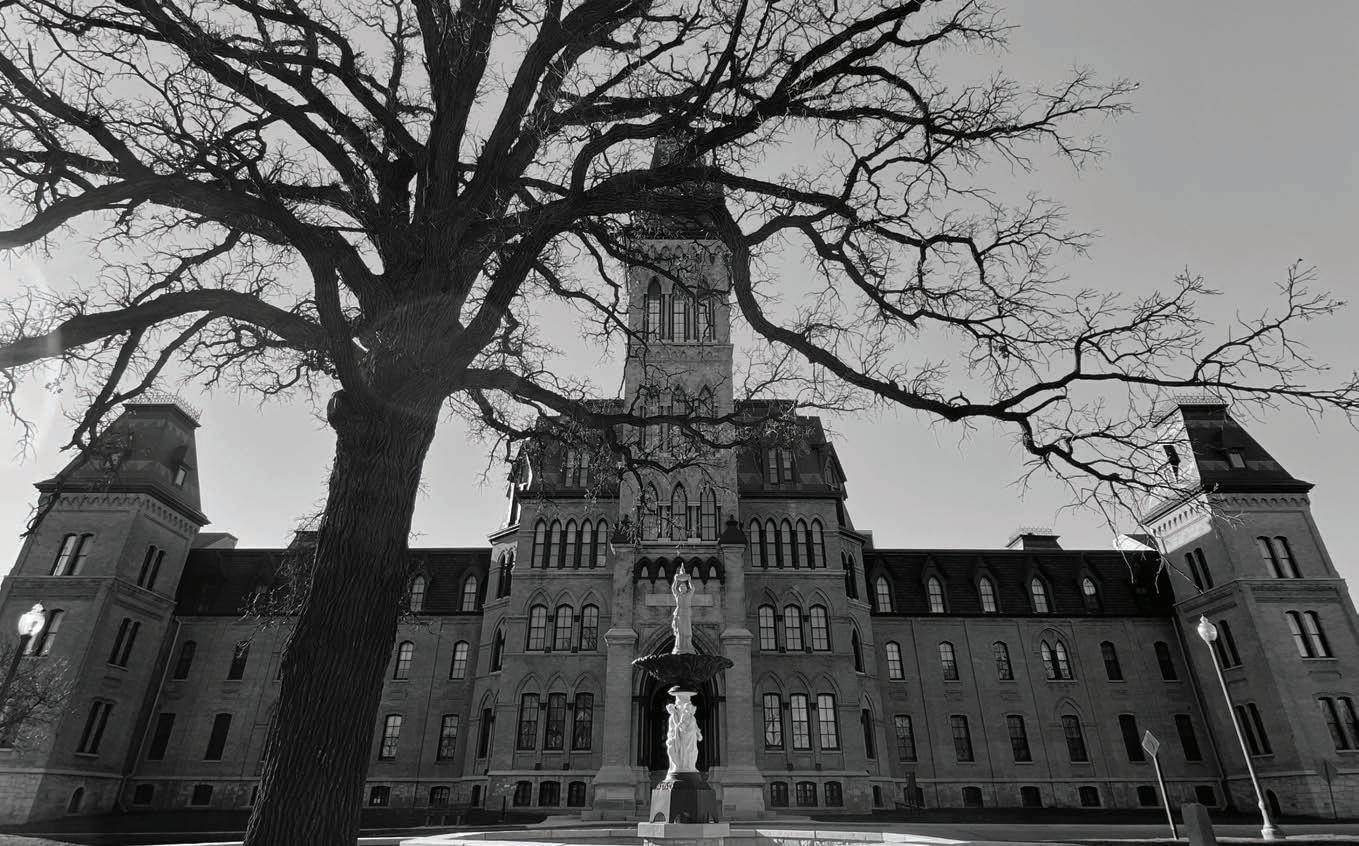
12 minute read
Milwaukee Veterans at Risk of Homelessness
BY ANTHONY MARK HAPPEL
MILWAUKEE SOLDIERS HOME OLD MAIN
Advertisement
Imagine what it is like to live outside, to be without a roof over your head, to be homeless. Everything you own is in your car or, maybe, a duffel bag. Think about all the things impacted by having no home. No respite from the elements. No safe place to sleep or store your belongings. No privacy. No place to hide out from the world. Think about what it is like to be without a kitchen or a bathroom.
Now, imagine dealing with a chronic health or a mental health issue. With so many things already working against you, how do you manage? How do you make sure you have clean clothes for appointments? How do you groom yourself? The issue of self-care is central to everything we do, and critical to how we present in the workplace and the world.
Being homeless challenges self-confidence and self-esteem. Being homeless is a constant reminder you are not fully functional because homelessness is a dysfunctional state, made worse when multiple issues need to be addressed. It is always a complex confluence of events that causes someone to become homeless. And something as simple as not having a vehicle, for example, can become a primary hindrance. Those with no or limited income are hustling agencies and social workers for bus passes and Uber gift cards. Not being able to travel freely causes more stress and anxiety while in an already stressful state. the Veteran’s Administration system, 1.4 million are at risk of homelessness or are/have been intermittently homeless. In Milwaukee, they can turn to the VA’s Zablocki Medical Center, a 10-storey facility with 189 beds that provides primary, secondary and tertiary care, covering 16 Wisconsin counties.
The VA is tasked by law with providing as much support as possible and reasonable in most areas of a veteran’s life, with safe, secure housing being central to everything. If a veteran is homeless or on the verge of homelessness, the VA will be concerned with housing as well as all other pertinent issues. The VA may already be involved in assisting a veteran, or the veteran may be in a temporary shelter or housing of some kind. Housing represents a long-term issue that can pose ongoing problems for years.
The VA operates a national program, administered by outside agencies of various kinds, called Supportive Services for Veteran’s Families (SSVF), which assists veterans who are homeless and also keeps vets who need rental assistance in their homes, sometimes for a period of months so they can regain some control of their finances and their lives. In addition, there is a Housing & Urban Development (HUD) program called HUD-VASH (Veteran Assisted Supportive Housing) that provides longer-term rental assistance for qualifying veterans and their families who need an extended time to deal with financial and other matters. The agencies the VA utilizes to administer SSVF,
like the Center for Veteran’s Issues in Milwaukee, also provide other assistance separate from housing to create added stability in a housing crisis situation.
According to VA Public Affairs Officer Ann Knabe, “HUD-VASH is currently serving approximately 550 veterans in Southeastern Wisconsin. Our program has had to adapt to the [municipal] housing authorities being closed and adjust our practices of assisting veterans with their housing search due to the pandemic. We are also fortunate to have access to CARES Act funding to temporarily place our most vulnerable veterans in hotels. We also collaborate with several community agencies to share resources.”
FRUSTRATION, ALIENATION
Despite the best efforts by the VA, veterans may be bouncing around from one office and agency to another. With mobility issues this can result in a lot of frustration and a sense of alienation. Veterans can find they are not getting the answers they need and are often also receiving what they perceive as incomplete or conflicting information. Marine veteran Mark Lalik, residing [as of this writing] at Vet’s Place Central, has dealt with substance abuse issues while homeless, and has experienced a level of frustration not unusual among some veterans, “Ninety percent of what I learned about the VA was through word of mouth. It’s a lot of runaround.”
He also notes services at the VA tend to be compartmentalized and narrowly focused and not always adaptable, “The VA is very cookie cutter. I see how a lot of people get turned off, it’s such a big organization … and you have to be really specific about what question you ask. They won’t elaborate.”
Army Veteran Spike Gavinski, who is also residing at Vet’s Place Central, commented that “the time it takes to get into the VA system is frustrating.” But he also noted that once you are in the system you get help, “as vets we look out for each other. If you ever watch the interaction of vets down at the VA hospital, at Zablocki, if there’s somebody that needs anything, if something falls on the floor, can I help you? Can I help you into your car?”
LEARNING BY ACCIDENT
Some veterans learn about their benefits by accident. Air Force veteran Michael Arns, a dental assistant who had been involved in the Rapid Re-housing program while staying at the Salvation Army, learned he was eligible for VA benefits when he went to
the VA Community Resource and Referral Center, “During the application process of the Rapid Re-housing program the application process of the Rapid Re-housing program I mentioned that I was a veteran and they informed me I mentioned that I was a veteran and they informed me that I could be eligible for veteran’s benefits. They told that I could be eligible for veteran’s benefits. They told me to pursue that, and they gave me the address to the me to pursue that, and they gave me the address to the Resource Center.” His message to veterans feeling lost in the system is, “Have patience and understanding … and realize that veterans—we’re a big family is what we are. We take care of each other. I’ve had a lot of people help me out of the blue, out of nowhere.” With COVID-19, shelters and programs shut down across the country, leaving homeless veterans more vulnerable to lack of proper shelter and temporary housing. And we apparently do not have the social and political will to improve the situation. Before COVID, HUD reported a 70% increase in homelessness among veterans from the previous year. That is a red flag and a clear indication we are not able to manage the care of veterans while also dealing with the issue of homelessness. Although COVID also made outreach to the homeless population very difficult, the Milwaukee County Veteran’s Service Office (CVSO) maintained operations throughout the pandemic. There is a CVSO in every county and every tribal nation in the state, per state statute. According to Director of Veteran’s Services for Milwaukee County, Rick Flowers, “Throughout COVID we have maintained the same services as pre-COVID levels. We did not disrupt any of our services during COVID.” The counties and CVSOs play an extremely important role in the lives of veterans in a number of areas. Flowers explains, “We assist veterans in obtaining a full range of federal, state and local benefits. We also partner with local agencies to provide other services including workforce readiness, legal services, counseling services, child support, energy assistance and eviction prevention.” They also assist veterans who are outside the VA system and not eligible for VA healthcare.
His message to veterans feeling lost in the system is, “Have patience and understanding … and realize that veterans—we’re a big family is what we are. We take care of each other. I’ve had a lot of people help me out of the

With COVID-19, shelters and programs shut down across the country, leaving homeless veterans more vulnerable to lack of proper shelter and temporary housing. And we apparently do not have the social and political will to improve the situation. Before COVID, HUD reported a 70% increase in homelessness among
outreach to the homeless population very difficult, the Milwaukee County Veteran’s Service Office (CVSO) maintained operations throughout the pandemic. There is a CVSO in every county and every tribal nation in the state, per state statute. According to Director of Veteran’s Services for Milwaukee County, Rick Flowers, “Throughout COVID we have maintained the same services as pre-COVID levels. We did not disrupt any of our services during COVID.”

The counties and CVSOs play an extremely important role in the lives of veterans in a number of areas. Flowers explains, “We assist veterans in obtaining a full range of federal, state and local benefits. We also partner with local agencies to provide other services including workforce readiness, legal services, counseling services, child support, energy assistance and eviction prevention.” They also assist veterans who are outside the VA system and not eligible for VA healthcare.
SOLDIERS HOME
In March of 2021 the Soldiers Home opened in Milwaukee, a $44 million renovation project that reMilwaukee, a $44 million renovation project that repurposes an historic landmark to house homeless purposes an historic landmark to house homeless veterans. The building itself had been under veterans. The building itself had been under re-use consideration of some kind since re-use consideration of some kind since at least 2004. In 2016 the Alexander at least 2004. In 2016 the Alexander Company took the lead when the Department of Veteran’s Affairs Company took the lead when the Department of Veteran’s Affairs issued a request for proposals, and they ultimately oversaw issued a request for proposals, and they ultimately oversaw the design and construction. They then joined forces with the design and construction. They then joined forces with the City of Milwaukee Housing Authority, the agency that the City of Milwaukee Housing Authority, the agency that administers the housing vouchers to veterans for the HUDadministers the housing vouchers to veterans for the HUDVASH program at the Soldiers Home. VASH program at the Soldiers Home.

The facility has 101 units of supportive housing, including The facility has 101 units of supportive housing, including 14 single room units. According to Amy Mauel, Program 14 single room units. According to Amy Mauel, Program Manager of the Milwaukee VA Homeless Prevention Manager of the Milwaukee VA Homeless Prevention Program, they are currently at about 85% capacity, “There Program, they are currently at about 85% capacity, “There are vouchers available and veterans can access the are vouchers available and veterans can access the program through the homeless hotline, and they can also program through the homeless hotline, and they can also walk into the Community Resource and Referral Center on walk into the Community Resource and Referral Center on
Martin Luther King Boulevard,” she says. They also assist Martin Luther King Boulevard,” she says. They also assist veterans who want to live in the community. veterans who want to live in the community.
Army veteran Empson Rowell, who has Army veteran Empson Rowell, who has been at the Soldiers Home since it been at the Soldiers Home since it opened, had faced numerous opened, had faced numerous added obstacles while he added obstacles while he living in a shelter and trying living in a shelter and trying to resolve his housing, one to resolve his housing, one of them involving dental of them involving dental care, “I had to be homeless care, “I had to be homeless to qualify for dental care, to qualify for dental care, and I had to get that done while I and I had to get that done while I was homeless,” he said. After receiving was homeless,” he said. After receiving dental care, he was able to begin the process of dental care, he was able to begin the process of addressing housing. addressing housing.
While living at the shelter Rowell says, “I got a lot of While living at the shelter Rowell says, “I got a lot of help. HUD VASH had an open-door policy. It was a help. HUD VASH had an open-door policy. It was a good fit.” He explains he knew there was something good fit.” He explains he knew there was something different about the Soldiers Home, “I was optimistic different about the Soldiers Home, “I was optimistic about coming here,” he continues, “it was going to be about coming here,” he continues, “it was going to be different, not like standard government housing.” different, not like standard government housing.”
The Soldiers Home is a special place with a special The Soldiers Home is a special place with a special purpose, and it has already had a profound impact purpose, and it has already had a profound impact in our community and in the lives of the people who in our community and in the lives of the people who have found a home there. It stands as a powerful have found a home there. It stands as a powerful example of what can be done with a publicexample of what can be done with a publicprivate partnership, and it is a model for other private partnership, and it is a model for other cities to examine to find their own pathways to cities to examine to find their own pathways to something similar. something similar.
We can see we need to do more, but what, We can see we need to do more, but what, exactly? Members of the medical community exactly? Members of the medical community and social workers say we need both easier and social workers say we need both easier and more effective communication and better and more effective communication and better inter-integration of agencies, programs and inter-integration of agencies, programs and services. Some veterans will tell you the VA services. Some veterans will tell you the VA needs better communication and better needs better communication and better integration of services and agencies, and integration of services and agencies, and they need to be more transparent. they need to be more transparent.










